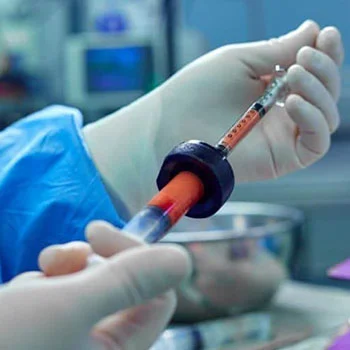What is breast implant removal?
Breast implant removal, also known as explantation, is a surgical procedure performed to remove breast implants from the body. Breast implants are removed for various reasons, including personal choice, complications like capsular contracture or implant rupture, health concerns such as breast implant illness, and the natural aging of implants. Some individuals opt for removal to return to their natural breast size or address long-term health worries.
Breast implant removal surgery typically involves making incisions to access the implants, removing the implants, and addressing any surrounding scar tissue or other issues as needed. Depending on the individual's goals and circumstances, additional procedures such as breast lift (mastopexy) or fat grafting may be performed during the same surgery to achieve the desired aesthetic outcome.
Why you might want to have your breast implants removed
There are several reasons why someone might consider having their breast implants removed. Common reasons people choose to have their implants removed include:
- Personal preferences: Some individuals may choose to have their breast implants removed or replaced due to changes in aesthetic preferences or a desire to return to their natural breast size and shape.
- Complications: Reasons for implant removal can include complications such as capsular contracture (excessive scar tissue around the implant), implant rupture, implant malposition, or other issues that affect the appearance or comfort of the breasts.
- Health concerns: Concerns about potential health risks associated with breast implants, such as breast implant illness or autoimmune reactions, may prompt individuals to consider implant removal.
- Implant end of life: Breast implants are not considered lifetime devices and may need to be removed or replaced over time due to natural aging, changes in breast anatomy, or the need for revision surgery.
Discussing these factors with a plastic surgeon specializing in breast surgery can help individuals make informed decisions about whether breast implant removal is the right choice for them.
How are breast implants removed?
Breast implant removal is typically performed through a surgical procedure that involves the following steps:
- Anesthesia: The procedure is usually performed under general anesthesia to ensure the patient's comfort and safety during the surgery.
- Incision: The surgeon makes incisions to access the breast implants. The incision location can vary depending on factors such as the type of implant, previous incision sites, and the need for additional procedures.
- Implant removal: The surgeon carefully removes the breast implants from the breast pocket. This may involve detaching the implants from surrounding tissues and dissecting any scar tissue (capsule) that has formed around the implants.
- Capsule management: In some cases, the surgeon may opt to remove part or all of the scar tissue capsule surrounding the implant. This step is known as a capsulectomy.
- Closure: Once the implants and any surrounding scar tissue are removed, the incisions are closed with sutures. The surgeon may use techniques to minimize scarring and promote optimal wound healing.
Depending on the individual's goals and circumstances, additional procedures such as breast lift (mastopexy) or fat grafting may be performed during the same surgery to address changes in breast shape or volume that may occur after implant removal.
Following the procedure, patients are typically provided with post-operative care instructions to promote healing and reduce the risk of complications. It is essential to attend follow-up appointments with the surgeon to monitor the healing process and address any concerns that may arise after breast implant removal surgery.
Breast implant removal techniques
There are different techniques used for breast implant removal, depending on factors such as the type of implants, the presence of scar tissue (capsules), and the patient's desired outcomes. Some common breast implant removal techniques include:
- En-bloc capsulectomy: In this technique, the surgeon removes the breast implant and the surrounding scar tissue capsule as a single unit. This method is often used when there are concerns about implant rupture or to ensure complete removal of the capsule.
- Total capsulectomy: The surgeon removes the entire scar tissue capsule surrounding the implant separately from the implant itself. This technique is used to address issues such as capsular contracture or to reduce the risk of recurrent capsule formation.
- Partial capsulectomy: In this approach, the surgeon removes a portion of the scar tissue capsule while leaving some of it in place. This technique may be used when the capsule is thin, soft, or not causing complications.
- Implant removal with capsule preservation: In cases where the scar tissue capsule is thin, pliable, and not causing issues, the surgeon may opt to preserve the capsule and remove only the implant. This technique is chosen to maintain breast shape and minimize the risk of deformities post-surgery.
- Combination procedures: Depending on the individual's goals and needs, additional procedures such as a breast lift (mastopexy) or fat grafting may be performed concurrently with implant removal to address changes in breast shape, volume, or sagging that may occur after removal.
- Implant exchange: In some cases, patients may choose to replace their implants with new ones or undergo a breast augmentation revision at the time of implant removal. This approach allows for adjustments in breast size, shape, and symmetry while addressing concerns related to the previous implants.
The choice of technique for breast implant removal is personalized to each patient's unique circumstances and goals. It is important to discuss these options with a board-certified plastic surgeon specializing in breast surgery to determine the most appropriate approach for achieving the desired outcomes while minimizing risks and complications.
Breast implant removal and replacement
Breast implant removal and replacement, also known as revision breast augmentation, is a surgical procedure that involves removing existing breast implants and replacing them with new implants. This procedure is typically performed to address issues such as implant-related complications, changes in aesthetic preferences, or changes in the patient's body over time.
The surgeon will first remove the existing breast implants using appropriate techniques, such as en-bloc capsulectomy, total capsulectomy, or partial capsulectomy, depending on the condition of the implants and surrounding tissues.
Following implant removal, the surgeon will place new breast implants in the breast pockets. The choice of new implants (size, type, shape, and material) will be discussed with the patient based on their preferences and goals.
Breast implant removal and lift
After breast implants are removed, the skin that was stretched to accommodate the implants may lose elasticity and result in sagging or drooping breasts. Breast implants can also alter the natural shape and position of the breasts.
A breast lift (mastopexy) after breast implant removal can help reshape and lift the breasts to achieve a more youthful and aesthetically pleasing appearance. By combining implant removal with a breast lift, patients can restore their breasts to a more natural contour and position, enhancing overall breast aesthetics.
Breast lift surgery can also help improve breast symmetry by addressing differences in breast shape, size, or position that may have developed over time with implants. This can result in a more balanced and harmonious breast appearance.
Many patients opt for a breast lift in conjunction with implant removal to streamline their surgical experience, reduce overall recovery time, and achieve comprehensive aesthetic enhancements in a single procedure. This approach allows for addressing multiple concerns simultaneously.
For patients seeking cosmetic improvement or desiring a more lifted and rejuvenated breast appearance after implant removal, a breast lift can provide significant aesthetic benefits. It can help achieve firmer, perkier breasts with improved shape and projection.
How to prepare
Preparing for breast implant removal surgery involves several important steps to ensure a smooth and successful procedure. Here are some general guidelines on how to prepare for breast implant removal:
- Consultation with a plastic surgeon: Schedule a consultation with a board-certified plastic surgeon who specializes in breast surgery to discuss your goals, concerns, and expectations regarding breast implant removal. During the consultation, the surgeon will evaluate your medical history, perform a physical examination, and discuss the surgical plan.
- Medical evaluation: Your surgeon may recommend certain pre-operative tests, such as blood work or imaging studies, to assess your overall health and ensure you are a suitable candidate for surgery.
- Discuss expectations and options: Have a detailed discussion with your surgeon about the reasons for wanting breast implant removal, potential outcomes, risks, and benefits of the procedure. Ensure that you have a clear understanding of what to expect before, during, and after the surgery.
- Follow pre-operative instructions: Your surgeon will provide specific pre-operative instructions to follow, which may include guidelines on medications to avoid, fasting before surgery, and skincare routines. It is essential to adhere to these instructions to minimize the risk of complications and ensure the best possible surgical outcome.
- Arrange for transportation and support: Plan for someone to drive you to and from the surgical facility on the day of the procedure. Additionally, consider arranging for assistance at home during the initial days of recovery, as you may need help with daily activities.
- Prepare your recovery space: Create a comfortable and restful recovery space at home, with necessary items within reach, such as medications, pillows for elevation, loose and comfortable clothing, and entertainment to keep you occupied during the recovery period.
- Maintain a healthy lifestyle: Leading up to the surgery, focus on maintaining a healthy lifestyle by eating nutritious foods, staying hydrated, getting regular exercise, and avoiding smoking and excessive alcohol consumption, as these factors can impact the surgical outcome and recovery process.
- Ask questions: Don't hesitate to ask your surgeon any questions or address any concerns you may have about the procedure. Clear communication with your healthcare team is essential for a successful surgical experience.
By following these preparation steps and working closely with your plastic surgeon, you can help ensure a safe and successful breast implant removal surgery and a smooth recovery process.
What to expect after breast implant removal
After breast implant removal surgery, there are several key aspects to expect during the recovery period and beyond. Here are some common expectations following breast implant removal:
- Immediate postoperative period
- Discomfort and swelling: It is normal to experience some discomfort, swelling, and bruising around the surgical site immediately after the procedure.
- Drainage tubes: In some cases, drainage tubes may be placed to help remove excess fluid and aid in the healing process. Your surgeon will provide instructions on how to care for these tubes.
- Dressings and bandages: The incision sites may be covered with dressings or bandages, which should be kept clean and dry as instructed by your surgeon.
- Recovery timeline
- Activity restrictions: Your surgeon will provide guidelines on activity restrictions, such as avoiding strenuous exercise and lifting heavy objects, to promote proper healing.
- Follow-up appointments: You will need to attend follow-up appointments with your surgeon to monitor your healing progress, remove sutures if necessary, and address any concerns.
- Physical changes
- Changes in breast appearance: After implant removal, you may notice changes in the size, shape, and firmness of your breasts. Your surgeon may recommend additional procedures like a breast lift to achieve your desired aesthetic outcome.
- Scar healing: Incision scars will gradually fade over time, and your surgeon may recommend scar management techniques to help minimize their visibility.
- Emotional adjustment
- Body image concerns: It is common to experience a range of emotions following breast implant removal, including body image concerns and adjustments to your new appearance. Seeking support from loved ones or a counselor can be helpful during this time.
- Long-term follow-up:
- Monitoring for complications: Stay vigilant for any signs of complications such as infection, excessive swelling, or changes in breast sensation. Contact your surgeon immediately if you experience any concerning symptoms.
- Regular check-ups: It is important to attend regular follow-up appointments with your surgeon to monitor your breast health and address any long-term concerns.
By following your surgeon's post-operative instructions, maintaining open communication, and allowing yourself time to heal both physically and emotionally, you can navigate the recovery process effectively and achieve the best possible outcomes following breast implant removal.
What are the potential risks of breast implant removal?
Breast implant removal, like any surgical procedure, carries potential risks and complications. Some of the risks associated with breast implant removal surgery include:
- Infection: There is a risk of developing an infection at the surgical site, which may require treatment with antibiotics or additional interventions.
- Bleeding: Excessive bleeding during or after the surgery can occur, leading to hematoma formation and the potential need for further surgical intervention.
- Changes in breast sensation: Numbness, altered sensation, or changes in nipple sensitivity may occur following breast implant removal surgery, although these effects are often temporary.
- Scarring: The formation of visible or raised scars at the incision sites is a common risk of any surgical procedure, including breast implant removal.
- Capsular contracture: In cases where the scar tissue capsule around the implant is not completely removed during the surgery, there is a risk of capsular contracture recurrence, which may cause discomfort or changes in breast shape.
- Changes in breast appearance: Following implant removal, changes in breast size, shape, or symmetry may occur, which may require additional procedures such as a breast lift or fat grafting to achieve desired aesthetic outcomes.
- Implant rupture or leakage: If the implants are ruptured or leaking at the time of removal, there is a risk of silicone or saline leakage into the surrounding tissues, necessitating thorough cleaning and management.
- Hematoma and seroma: The accumulation of blood (hematoma) or fluid (seroma) in the surgical site can lead to pain, swelling, and potential complications that may require drainage.
- Anesthesia risks: General anesthesia carries inherent risks, including allergic reactions, respiratory problems, and adverse reactions to anesthesia medications.
- Unsatisfactory results: Despite the surgeon's best efforts, there is a risk that the final aesthetic outcome may not meet the patient's expectations, requiring additional procedures or revisions.
It is essential to discuss these potential risks and complications with your plastic surgeon during the consultation process and to follow all pre-operative and post-operative instructions carefully to minimize the occurrence of complications and promote a smooth recovery following breast implant removal surgery. Regular follow-up appointments and open communication with your healthcare provider are crucial for monitoring your healing progress and addressing any concerns that may arise.
How much does breast implant removal cost?
The cost of breast implant removal surgery can vary depending on several factors, including the geographic location of the surgical facility, the expertise of the plastic surgeon, the complexity of the procedure, the type of anesthesia used, the need for additional procedures (such as a breast lift or implant replacement), and the specific requirements of the individual patient.
On average, the cost of breast implant removal surgery in the United States can range from $3,000 to $10,000 or more. This estimated cost typically includes the surgeon's fee, anesthesia fees, facility fees, pre-operative tests, post-operative garments, and follow-up appointments.
It is important to note that the cost of breast implant removal may not be covered by health insurance unless there are specific medical reasons necessitating the removal, such as implant rupture or capsular contracture causing pain or deformity. Patients considering breast implant removal should consult with their plastic surgeon to obtain a personalized cost estimate based on their individual needs and treatment plan. Additionally, discussing payment options and potential financing plans with the surgical facility or healthcare provider can help make the procedure more financially manageable for patients.
FAQs
How long does a breast implant removal procedure take?
The duration of a breast implant removal procedure typically ranges from 1 to 3 hours, depending on factors such as the complexity of the case, the need for additional procedures, and the surgical technique employed.
Does breast implant removal surgery hurt?
Breast implant removal surgery is typically performed under general anesthesia, ensuring that the patient is completely asleep and pain-free during the procedure. After the surgery, patients may experience some discomfort, soreness, or mild pain at the incision sites and in the chest area. Pain medication will be prescribed to help manage any postoperative pain.
Is breast implant removal surgery easier than breast implant insertion?
Breast implant removal surgery can be technically more challenging than breast implant insertion, especially in cases involving scar tissue (capsules) or implant complications. The complexity of the procedure varies based on individual factors and the surgeon's experience.
Will breast implant removal leave new scars?
Breast implant removal may result in new scars, typically located around the areola, under the breast crease, or along the inframammary fold, depending on the surgical approach and incision placement. Scarring can vary in visibility and fade over time with proper care.
Will I get breast sagging if I get my breast implants removed?
Breast sagging may occur after breast implant removal, especially if the implants were in place for a long time or if there was significant stretching of the skin. To address skin sagging, a breast lift (mastopexy) may be recommended during the removal procedure to reshape and lift the breasts for a more youthful appearance




